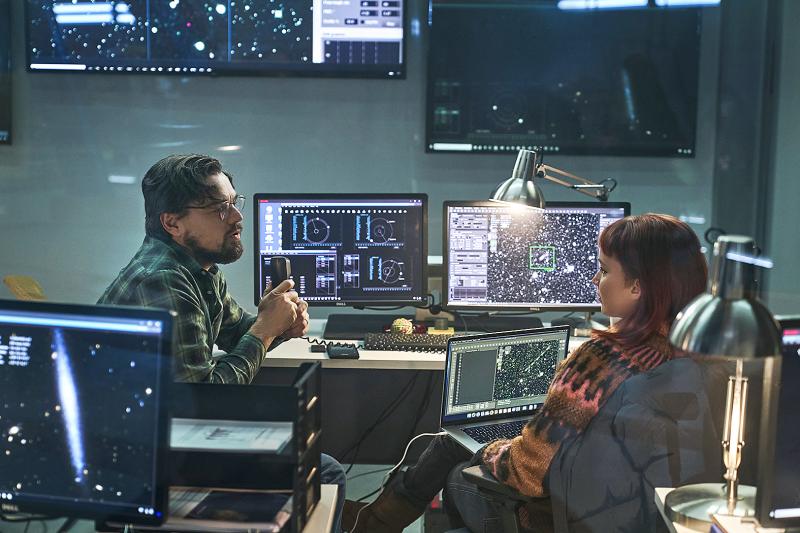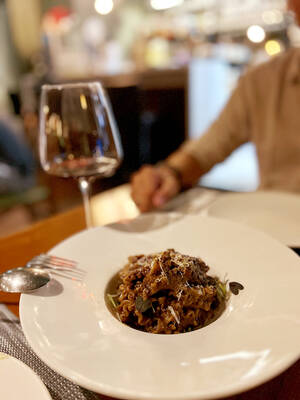Don’t Look Up, the latest celluloid offering from the writer-director Adam McKay, has become Netflix’s top film globally despite dividing critics and viewers.
The film, a satire in which two scientists played by Leonardo DiCaprio and Jennifer Lawrence attempt to warn an indifferent world about a comet that threatens to destroy the planet, is an intentional allegory of the climate crisis.
Despite a stellar cast also featuring Meryl Streep, Cate Blanchett, Mark Rylance, Jonah Hill and Timothee Chalamet, the movie has received a frosty reception from many film critics.

Photo: AP
But the lukewarm critical reception contrasts sharply with the response from the film’s allegorical heroes: climate scientists and activists.
David Ritter, chief executive of Greenpeace Asia Pacific, says he was struck by the sense of desperation portrayed by the film’s scientists, finding the parallel with the climate crisis “very, very powerful.”
“There are tens or hundreds of thousands of people across the world who are scientists, activists, campaigners … giving their lives to this work,” Ritter said. “The sheer number of people who have asked me ... what is wrong with our political leaders that they do not understand?”

Photo: AP
Prof Matthew England, co-founder of the Climate Change Research Centre at the University of New South Wales, said Don’t Look Up was a “brilliant film.”
“It parodies our inaction to tackle climate change beautifully well, especially in relation to conservative government and the mainstream media,” England says. “I loved it and I understand a lot of climate scientists have the same reaction, whereas the mainstream media perhaps is feeling defensive because it is part of what is attacked in the film.”
Daniel Bleakley, a Melbourne-based climate activist, agreed, saying he hoped the “fantastic film” would draw attention to media reporting of the climate crisis.
“If we really want the broad public to start understanding the seriousness and urgency of the climate crisis, we need our media to be communicating it effectively.”
Bleakley said the film articulated a sense among climate activists of having their messages fall on deaf ears over many years.
“I have heard from a number of activists that after watching the film, they’ve felt heard, they’ve felt recognized.
“As activists and as climate scientists who truly understand the gravity and the seriousness and the urgency of the climate crisis — and the fact that every day counts — it’s almost surreal when you walk around in the world and see people going about their daily lives like everything’s completely normal.”
Ritter disagrees with criticism that the film lacks nuance.
“When someone says it was really heavy-handed, what were they talking about?” he asks.
“Were they talking about the subtle depiction of the way in which vested interests can institutionally corrupt the public good? Were they talking about the threat of unconstrained techno-optimistic capitalism?”
“The use of the scenes of chaos and drama interspersed with the interaction of characters in a more quiet, reflective mode … I thought it was particularly striking and evocative of how one experiences a world that is grappling with the climate crisis.”
“Don’t listen to the reviews,” Ritter added. “Watch the film — make your own mind up.”
The Guardian’s critics have described the film as a “ labored, self-conscious and unrelaxed satire,” and a “toothless comedy” that comes from a “position of lofty superiority that would drive away any partisans who still need to be won over.”

Last week gave us the droll little comedy of People’s Republic of China’s (PRC) consul general in Osaka posting a threat on X in response to Japanese Prime Minister Sanae Takaichi saying to the Diet that a Chinese attack on Taiwan may be an “existential threat” to Japan. That would allow Japanese Self Defence Forces to respond militarily. The PRC representative then said that if a “filthy neck sticks itself in uninvited, we will cut it off without a moment’s hesitation. Are you prepared for that?” This was widely, and probably deliberately, construed as a threat to behead Takaichi, though it

Nov. 17 to Nov. 23 When Kanori Ino surveyed Taipei’s Indigenous settlements in 1896, he found a culture that was fading. Although there was still a “clear line of distinction” between the Ketagalan people and the neighboring Han settlers that had been arriving over the previous 200 years, the former had largely adopted the customs and language of the latter. “Fortunately, some elders still remember their past customs and language. But if we do not hurry and record them now, future researchers will have nothing left but to weep amid the ruins of Indigenous settlements,” he wrote in the Journal of

Even after years in business, weekend tables here can be booked out a month in advance. The price point far exceeds its competitors. Granted, expectations are soaringly high, but something here failed to hit the high notes. There are a few telltale signs that a restaurant relies solely on outstanding food to create the experience, no gimmicks or distractions needed. La Mole is such a restaurant. The atmosphere is food-forward, with an open kitchen center stage. Our tables are simple; no candles, no dim lighting, no ambient music. The menu is brief, and our waiter directs most

If China attacks, will Taiwanese be willing to fight? Analysts of certain types obsess over questions like this, especially military analysts and those with an ax to grind as to whether Taiwan is worth defending, or should be cut loose to appease Beijing. Fellow columnist Michael Turton in “Notes from Central Taiwan: Willing to fight for the homeland” (Nov. 6, page 12) provides a superb analysis of this topic, how it is used and manipulated to political ends and what the underlying data shows. The problem is that most analysis is centered around polling data, which as Turton observes, “many of these